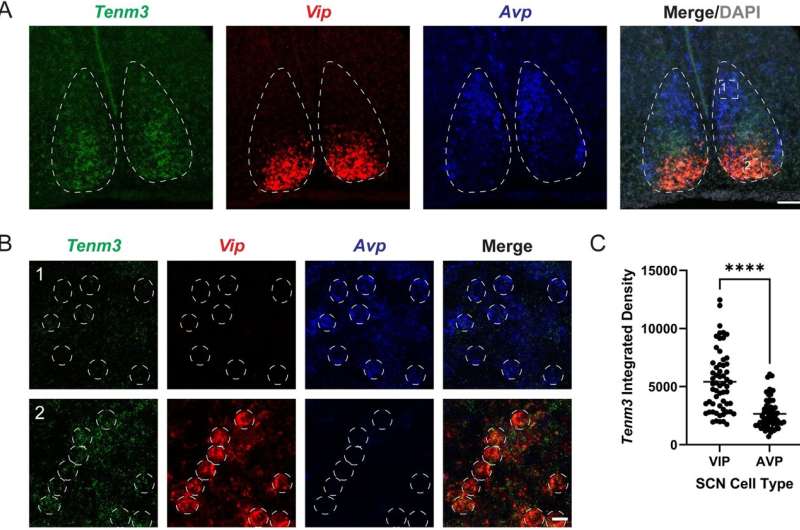This article has been reviewed according to Science X's editorial process and policies. Editors have highlighted the following attributes while ensuring the content's credibility:
fact-checked
peer-reviewed publication
trusted source
proofread
Study identifies 'visual system' protein for circadian rhythm stability

Scientists at the Johns Hopkins University School of Medicine and the National Institutes of Health have identified a protein in the visual system of mice that appears to be key for stabilizing the body's circadian rhythms by buffering the brain's response to light. The finding, published Dec. 5 in PLoS Biology, advances efforts to better treat sleep disorders and jet lag, the study authors say.
"If circadian rhythms adjusted to every rapid change in illumination, say an eclipse or a very dark and rainy day, they would not be very effective in regulating such periodic behaviors as sleep and hunger. The protein we identified helps wire the brain during neural development to allow for stable responses to circadian rhythm challenges from day to day," says Alex Kolodkin, Ph.D., professor in the Johns Hopkins Department of Neuroscience and deputy director for the Institute for Basic Biomedical Sciences.
Kolodkin co-led the study with Samer Hattar, Ph.D., chief of the Section on Light and Circadian Rhythms at the National Institute of Mental Health.
Scientists have long known that most living things have a circadian "clock," a set of biological rhythms that operate on about a 24-hour cycle and that affect alertness, sleepiness, appetite and body temperature, among other cyclic behaviors.
Upsetting this system—through shift work or long-distance travel over multiple time and light zones in humans, for example—can have severe consequences. Previous studies link persistent upsets in circadian rhythm to increased risk of cancer, depression and a host of other medical problems.
Circadian systems are essentially "trained" by exposure to light. Although researchers have made significant headway over the last few decades in outlining the mechanisms responsible for circadian rhythms, it has remained unclear how the brain becomes wired for them.
To learn more, Kolodkin and Hattar, along with study first authors John Hunyara and Kat Daly and their colleagues, searched a database for biological molecules present during development in the mouse brain's control center for circadian rhythms—the suprachiasmatic nucleus (SCN).
Located deep within both the mouse and human brain in the hypothalamus, the SCN sits near areas that control vision and makes connections with brain cells that lead to the retina, the light-sensing part of the eye.
The research team quickly zeroed in on a cell surface protein called teneurin-3 (Tenm3), part of a larger family of proteins that play key roles in the visual system circuit assembly and more generally in other central nervous system circuits.
When the researchers genetically altered mice to prevent Tenm3 production, the animals developed fewer connections between the retina and the SCN, compared with animals with intact Tenm3. However, the mice lacking Tenm3 developed far more connectivity between cells in the core and shell of the SCN, where Tenm3 tends to localize.
To see how Tenm3 might stabilize circadian rhythms or subject them to disruption by even a tiny bit of light, the scientists designed a set of experiments.
First, they trained mice lacking Tenm3 on a 12-hour light/dark cycle, then shifted the dark period ahead by six hours. Mice with intact Tenm3 took about four days to readjust their circadian rhythms to the shift, as measured by activity patterns diagnostic of normal sleep cycles. The animals without Tenm3, however, adjusted far more rapidly, in about half the time.
When the researchers performed a similar experiment with light twice as dim as in the earlier test, it took the Tenm3-intact mice about eight days to adjust their circadian cycles, but only about four days for the mice without Tenm3.
Even just a 15-minute pulse of dim light triggered the Tenm3-lacking mice—but not the mice with normal Tenm3 protein—to produce a brain chemical that serves as a proxy for light exposure, suggesting a heightened sensitivity to light cues necessary for setting or resetting the circadian clock.
These findings suggest to the authors that Tenm3 helps wire the brain to maintain stable circadian rhythms even when light exposure is variable. By learning more about this system and Tenm3's role, says Hattar, researchers may eventually be able to diagnose and treat glitches that lead to insomnia and other sleep disorders in people, or possibly develop treatments for jet lag.
"There are very clear implications for human health," he says.
More information: John L. Hunyara et al, Teneurin-3 regulates the generation of non-image-forming visual circuitry and responsiveness to light in the suprachiasmatic nucleus, PLOS Biology (2023). DOI: 10.1371/journal.pbio.3002412




















